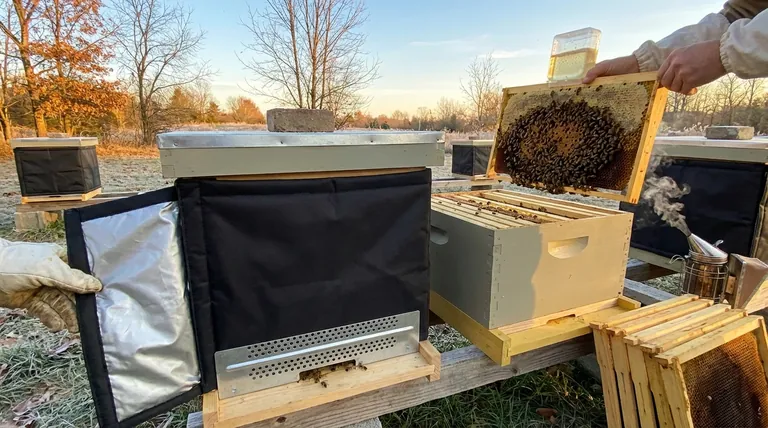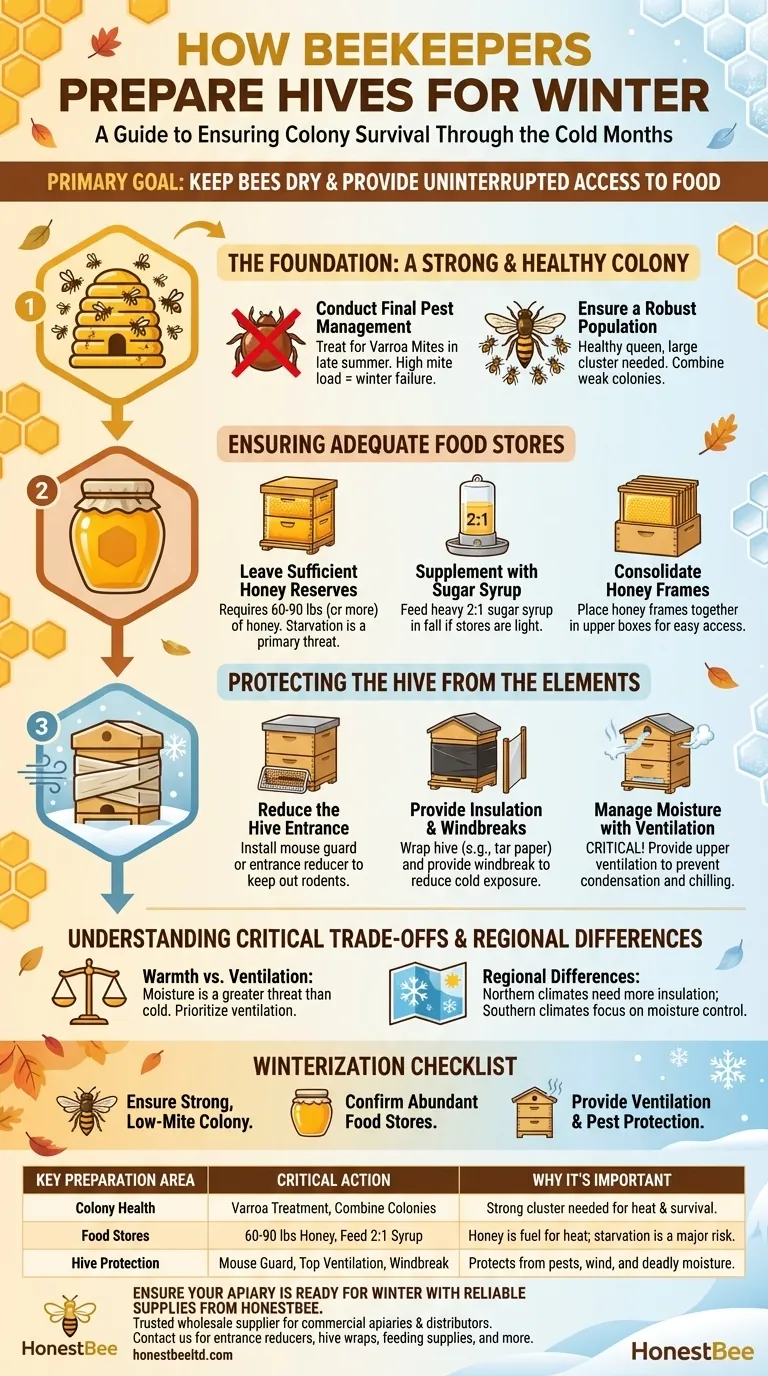To prepare a beehive for winter, a beekeeper’s work in the late summer and fall focuses on three critical areas: ensuring the colony is strong and disease-free, confirming it has ample food stores to last until spring, and protecting the physical hive from moisture, wind, and pests. These proactive steps are essential for the colony's survival through the cold months.
The primary goal of winterizing a beehive is not to keep the bees warm—they generate their own heat. The true objective is to keep them dry and provide uninterrupted access to their food source, which is the fuel they need to survive.

The Foundation: A Strong and Healthy Colony
A colony's ability to survive winter is determined long before the first frost. A large, healthy population is the engine that will generate heat and sustain the queen.
Conduct Final Pest Management
The single greatest threat to a wintering colony is often the Varroa mite. These pests weaken bees and transmit viruses, crippling the colony when it can least afford it.
Beekeepers must test for mite levels in the late summer and apply appropriate treatments if thresholds are exceeded. A colony entering winter with a high mite load is unlikely to survive.
Ensure a Robust Population
A large cluster of bees is necessary to generate sufficient heat. This requires a healthy, productive queen laying eggs well into the fall.
Combining weak colonies in the autumn can sometimes be a better strategy than trying to overwinter two colonies that are unlikely to survive on their own.
Ensuring Adequate Food Stores
Honey is not a surplus for the beekeeper; it is the colony's essential winter fuel. The cluster of bees consumes honey to vibrate their wing muscles, generating the heat needed to keep the core temperature stable.
Leave Sufficient Honey Reserves
After the final honey harvest, a beekeeper must assess the hive's weight. A full-depth hive box filled with honey weighs a significant amount, and a colony may need 60-90 pounds (or more) to survive winter, depending on the climate's severity and length.
It is always better to leave too much honey than too little. Starvation is a primary cause of winter colony loss.
Supplement with Sugar Syrup
If honey stores are light, beekeepers feed the bees a heavy sugar syrup (a 2:1 ratio of sugar to water). This allows the bees to store the syrup in the comb, effectively replacing the honey that was harvested.
This feeding must be completed in the fall while temperatures are still warm enough for the bees to process and store the syrup.
Consolidate Honey Frames
Bees may not be able to cross empty frames of comb during a deep cold snap. Beekeepers organize the hive by placing all the frames of honey together, typically in the upper boxes.
This ensures the winter cluster can move upward as a cohesive group, staying in constant contact with their food source as the season progresses.
Protecting the Hive from the Elements
The physical hive structure must be secured against winter's three main threats: pests, wind, and moisture.
Reduce the Hive Entrance
Mice and other rodents seek warm, sheltered places to nest and will readily move into a beehive if given the chance. They will destroy comb and consume honey and bees.
Installing a mouse guard or an entrance reducer creates a barrier that is too small for a mouse to enter but large enough for bees to pass through.
Provide Insulation and Windbreaks
While bees generate their own heat, constant exposure to harsh winds can make it harder for them to maintain the cluster's temperature, causing them to consume food stores more rapidly.
Wrapping the hive, often with black tar paper or specialized hive wraps, reduces wind exposure. The black color can also absorb solar radiation on sunny days, providing a small amount of passive heat.
Manage Moisture with Ventilation
This is perhaps the most critical and misunderstood step. As bees consume honey and breathe, they release warm, moist air. When this air rises and hits the cold inner cover of the hive, it condenses into water.
This condensation can drip back down onto the cluster, chilling and killing the bees. To prevent this, beekeepers must provide adequate ventilation. This is often achieved by creating a small upper entrance or cracking the outer cover slightly to allow the moist air to escape.
Understanding the Critical Trade-offs
Winterizing is a balancing act. Understanding the principles behind the actions is more important than following a rigid set of rules.
Warmth vs. Ventilation
A common mistake is to insulate a hive so tightly that it cannot breathe. Moisture is a greater threat to a winter colony than cold. A dry, well-fed colony can survive extreme temperatures, but a wet colony cannot. Always prioritize ventilation.
Regional Differences
A beekeeper in a northern state with heavy snow and sub-zero temperatures will need to insulate more heavily than a beekeeper in a southern state with milder, wetter winters. The latter may need to focus more on ventilation and moisture control than on heavy wraps.
Your Winterization Checklist
Apply these principles based on your specific goals and environment to give your bees the best chance of a strong spring return.
- If you live in a severely cold and windy climate: Focus on heavy insulation and a solid windbreak, but ensure you provide a small upper entrance for moisture to escape.
- If you live in a damp, milder climate: Prioritize excellent ventilation and moisture control above all else; heavy insulation may not be necessary and could trap condensation.
- For all beekeepers, regardless of location: The most crucial factors are ensuring the colony is strong, has a very low Varroa mite load, and possesses an abundance of food stores before the first freeze.
Ultimately, proper winter preparation is the beekeeper's most important task in setting the colony up for a healthy and productive year to come.
Summary Table:
| Key Preparation Area | Critical Action | Why It's Important |
|---|---|---|
| Colony Health | Conduct Varroa mite treatment; combine weak colonies. | A strong, healthy bee cluster is essential for generating heat and surviving the cold. |
| Food Stores | Leave 60-90 lbs of honey; feed 2:1 sugar syrup if needed. | Honey is the fuel bees need to generate heat; starvation is a leading cause of winter loss. |
| Hive Protection | Install a mouse guard; provide top ventilation; use a windbreak. | Protects from pests and wind, while managing deadly condensation from bee respiration. |
Ensure your apiary is ready for winter with reliable supplies from HONESTBEE.
Preparing your hives for the cold months requires durable, high-quality equipment. As a trusted wholesale supplier for commercial apiaries and beekeeping equipment distributors, HONESTBEE provides the essential tools you need:
- Entrance reducers and mouse guards to protect against pests.
- Hive wraps and insulation materials to shield colonies from harsh winds.
- Feeding supplies to help build ample food reserves.
Let us help you safeguard your most valuable asset—your bees. Contact our team today to discuss your wholesale needs and ensure your colonies have a strong start next spring.
Visual Guide

Related Products
- Professional Insulated Winter Hive Wrap for Beekeeping
- Black Plastic Beetle Barn Hive Beetle Trap for Beehives
- Heavy-Duty Stainless Steel Clip-On Frame Perch
- Professional Grade Foldable Beehive Handles
- Long Langstroth Style Horizontal Top Bar Hive for Wholesale
People Also Ask
- What are the steps to properly wrap a beehive for winter? Ensure Your Colony Survives the Cold
- What are the benefits of insulated beehives in cold weather? Boost Winter Survival & Spring Productivity
- How does insulation help bee hives in severely cold weather? Conserve Energy & Ensure Colony Survival
- Should bee hives be insulated? Protect Your Colony from Moisture, Not Just Cold
- Why is insulation important for hives during winter? Ensure Your Bees Survive and Thrive



















